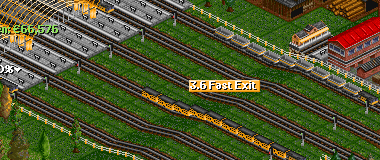Difference between revisions of "Tutorial Savegame Stations"
From #openttdcoop wiki
| Line 19: | Line 19: | ||
There is one very good argument: imagine you have a forest with a high production and a coal mine with a very small production. Furthermore, imagine the forest drops dramatically and the coal mine rises dramatically: wood trains may now block the whole station. Its a problem especially on very large maps because on maps like 1024x1024 you should keep the need for train management low - in one of #openttdcoop's largest games, Pile Transport (> 1000 trains), the train management was a lot of dull work due to many inappropriate stations built. | There is one very good argument: imagine you have a forest with a high production and a coal mine with a very small production. Furthermore, imagine the forest drops dramatically and the coal mine rises dramatically: wood trains may now block the whole station. Its a problem especially on very large maps because on maps like 1024x1024 you should keep the need for train management low - in one of #openttdcoop's largest games, Pile Transport (> 1000 trains), the train management was a lot of dull work due to many inappropriate stations built. | ||
| + | ==3.6 Fast Exit== | ||
| + | [[Image:Tutorial_Savegame_3.6.png|380px|frame|left]] | ||
| + | Ensure that a train leaves a station platform completely until it may get a red signal. This will lower the chances for platforms of being blocked by a slow or jammy exit therefore rising the efficiency of each platform. | ||
| + | <br style="clear: both;" /> | ||
[[Tutorial Savegame Sideline|<< 2.x Sideline]] | [[Tutorial Savegame Feeder|4.x Feeder >>]] | [[Tutorial Savegame Sideline|<< 2.x Sideline]] | [[Tutorial Savegame Feeder|4.x Feeder >>]] | ||
Revision as of 21:57, 17 July 2007
3.0 Stations
In this section one will find the most common techniques and tricks needed in order to construct some decent stations to our network.
3.1 Leave Waiting Space
A simple yet very important rule: leave a gap in front of a station to provide some waiting space if required. Depending on the output of the industry connected via the station you scale the amount of platforms (see 3.4) - scale the length of the waiting space as well! One of the worst things that could happen is an overflow of waiting trains at a station which queue back to a Sideline, therefore blocking it.
3.2 One-direction only needed
One of the big advantages of the sideline-concept: Sidelines-to-Station switches are very simple because its clear that only one direction is needed both for exit and entry.
3.3 Waiting Space for at least one Train
This is another example for the basic idea of 3.1: trains must never ever overflow in front of a station, therefore blocking it. If you have are really short on space for a long entry you can add some more station platforms to assure a train may always enter it.
3.4 Scale Station to Production
Correlated with 3.1 and 3.3: the more output expected, the more platforms needed at a station.
3.5 Avoid joining different Goods in one Station
There is one very good argument: imagine you have a forest with a high production and a coal mine with a very small production. Furthermore, imagine the forest drops dramatically and the coal mine rises dramatically: wood trains may now block the whole station. Its a problem especially on very large maps because on maps like 1024x1024 you should keep the need for train management low - in one of #openttdcoop's largest games, Pile Transport (> 1000 trains), the train management was a lot of dull work due to many inappropriate stations built.
3.6 Fast Exit
Ensure that a train leaves a station platform completely until it may get a red signal. This will lower the chances for platforms of being blocked by a slow or jammy exit therefore rising the efficiency of each platform.
